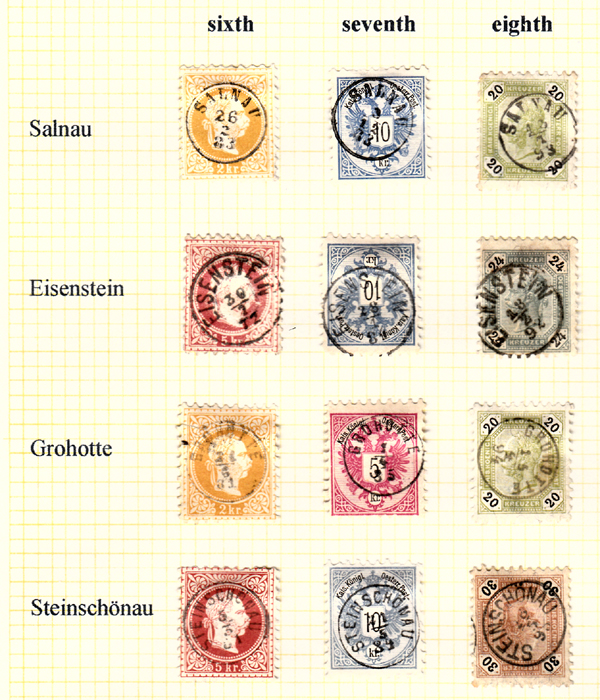
by Keith Brandon
| Back to Austrian Stamps homepage | Back to Articles list |
If we asked some collectors of Austrian material which was their favourite postmark type, we could be fairly sure that the so-called "thimble" would be at or near the top of the list. What could be more attractive than a well-struck thimble on an 1867 stamp? This popularity arises because the thimble is the only type of postmark that will fit completely on a loose stamp of the 19th century. Postal historians have mixed feelings, because if this cancel is accurately struck it doesn’t tie the stamp to the cover!

Thimble postmarks are by tradition defined as single circles with a maximum diameter of 20mm [a double-ring thimble postmark is known from Vienna (Klein type 444)] Not all of Austria’s post offices used thimbles, but some 1700 did. Colour and other variants bring the total to over 2000 different postmarks, a large field indeed for a collector seeking 'completion'.

Until 1867, single-circle postmarks were the predominant type, although oval, boxed and others were also used. But in 1867 a number of important events took place:
This last event led to the replacement of many cancellers. The single circle remained the most common postmark-type, but in Hungary the diameter of the circle was often enlarged to accommodate the year.

Perversely, the main Austrian response was the thimble postmark ("fingerhutstempel" in German), smaller than previous types, and introduced from 1 January 1868. It has been suggested that the small diameter was favoured so that a carefully-struck cancel would neatly frame the Emperor’s head on the 1867-issue stamp!
Thimble postmarks are usually defined as having a maximum diameter of 20mm, the largest that would fit completely on a loose Austrian stamp of the period. They can be found in various diameters from 16 to 20mm.


Although thimble postmarks were introduced after the instruction to include the year in the date, some have the year missing or blocked out by a "balken".

They are found on the stamps of the 6th (1867), 7th (1883), and 8th (1890/91) definitive issues, and on contemporaneous newspaper and postage-due stamps. They come from every province, as well as the Austrian post-offices in the Levant and the Austrian postal administration in Liechtenstein.

Thimbles on the 6th, 7th and 8th issues

Thimble postmarks used in the Levant.

Thimbles on newspaper and postage-due stamps
Thimble postmarks were also used in the "back-office" on contemporary receipts and forms, but that's outside the scope of this article.
There is a common misconception that thimble postmarks were not issued for the Hungarian-administered territory. They are much rarer than from the Austrian territory, but they do exist.

Initially these remained under Austrian control in 1867. Croatia-Slavonia transferred to Hungarian administration on 1 April 1868, the Military Border Districts following on 1 Jan 1871. During the brief period of Austrian administration, several offices introduced thimble postmarks – and these remained in use after the transfer to Hungary. These provide a further source of thimble postmarks on Hungarian territory and, from 1871, on Hungarian stamps.

Military Border District post offices still under Austrian control after 1 May 1867 and introducing thimbles.

Military Border District post offices under Hungarian control after 1 Jan 1871 and still using thimbles.
Changes to language laws led to the widespread introduction of dual-language postmarks in those parts of the Austrian half of the Empire where German (or Italian) was not the predominant language spoken. Two versions of the town name would not fit easily into a circle of 20mm or smaller. The days of the thimble-postmark were numbered as larger circles returned to favour.

Even in the German-speaking areas, the inclusion towards the end of the century of more information in cancellations, such as dispatch-codes and counter-letters, put pressure on the continued existence of the thimble. Generally there was a return to larger circles until the widely-used barred postmark made its entrance in the 1890s.

By 1874, thimble-cancellers were no longer being made, but their usage continued in many post-offices until as late as the 1890s. However, as the new century dawned, our story of the Austrian thimble postmark had come to its end.
| Back to Austrian Stamps homepage | Back to Articles list |
©APS 2 Aug 2016